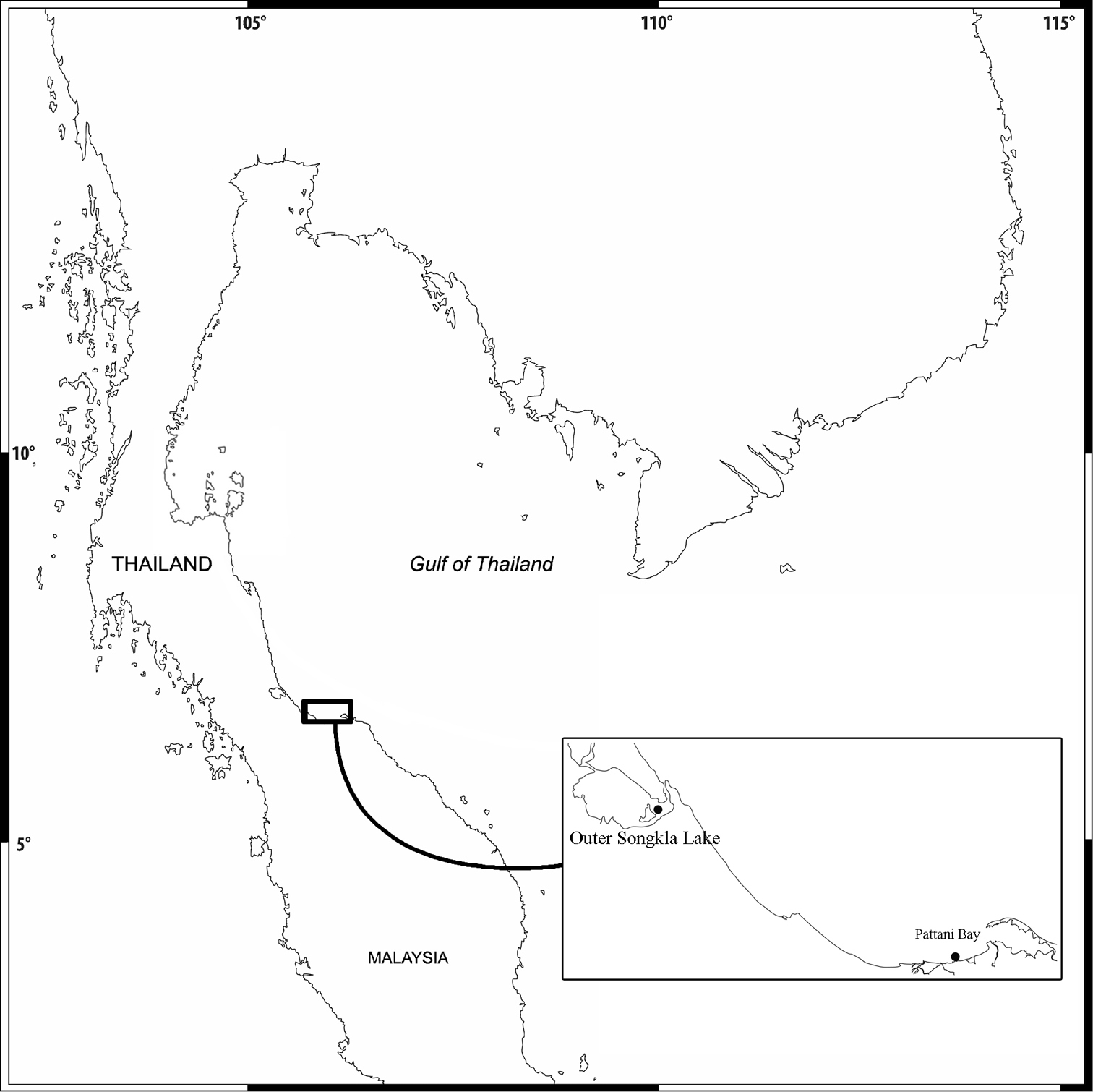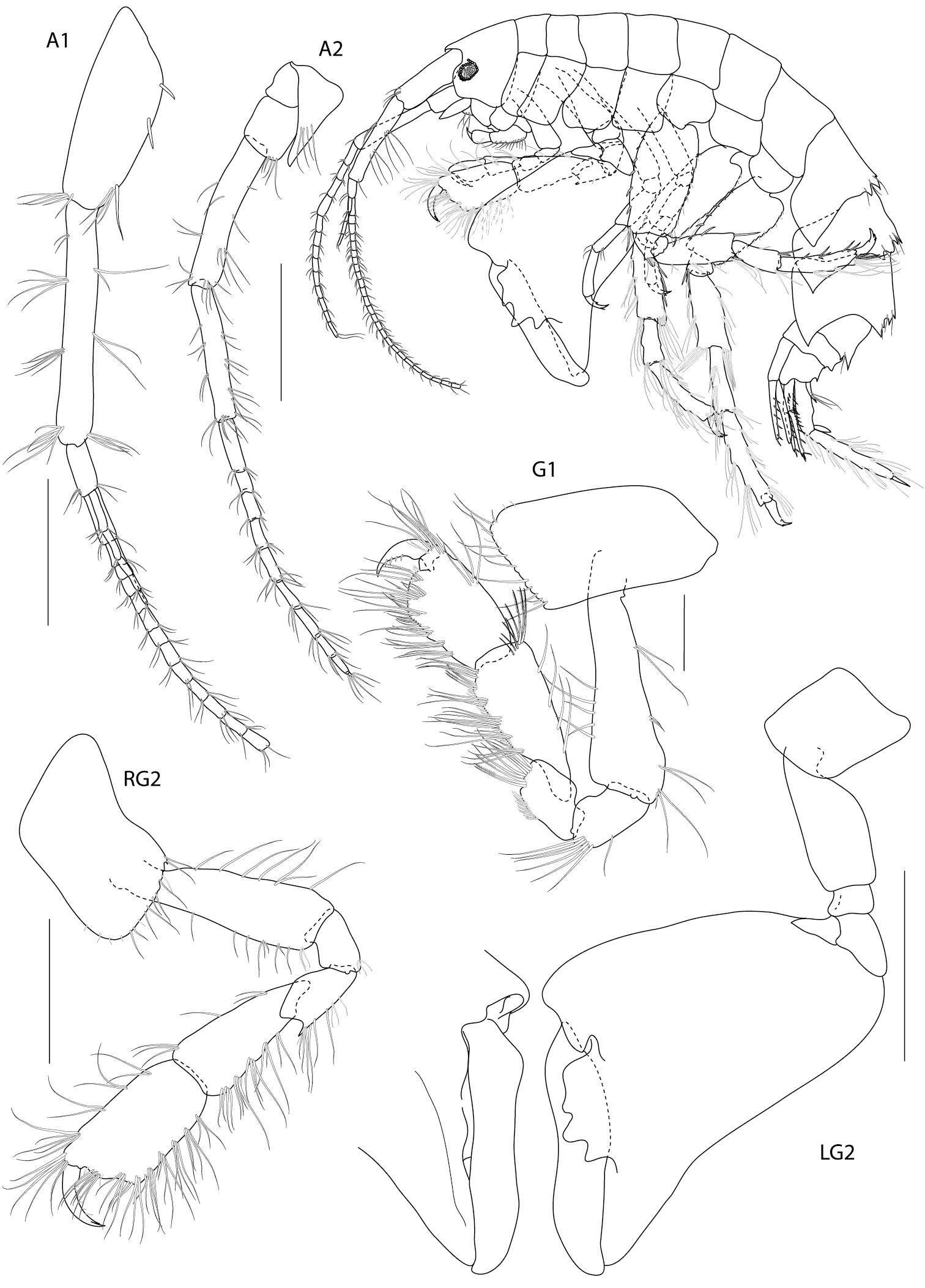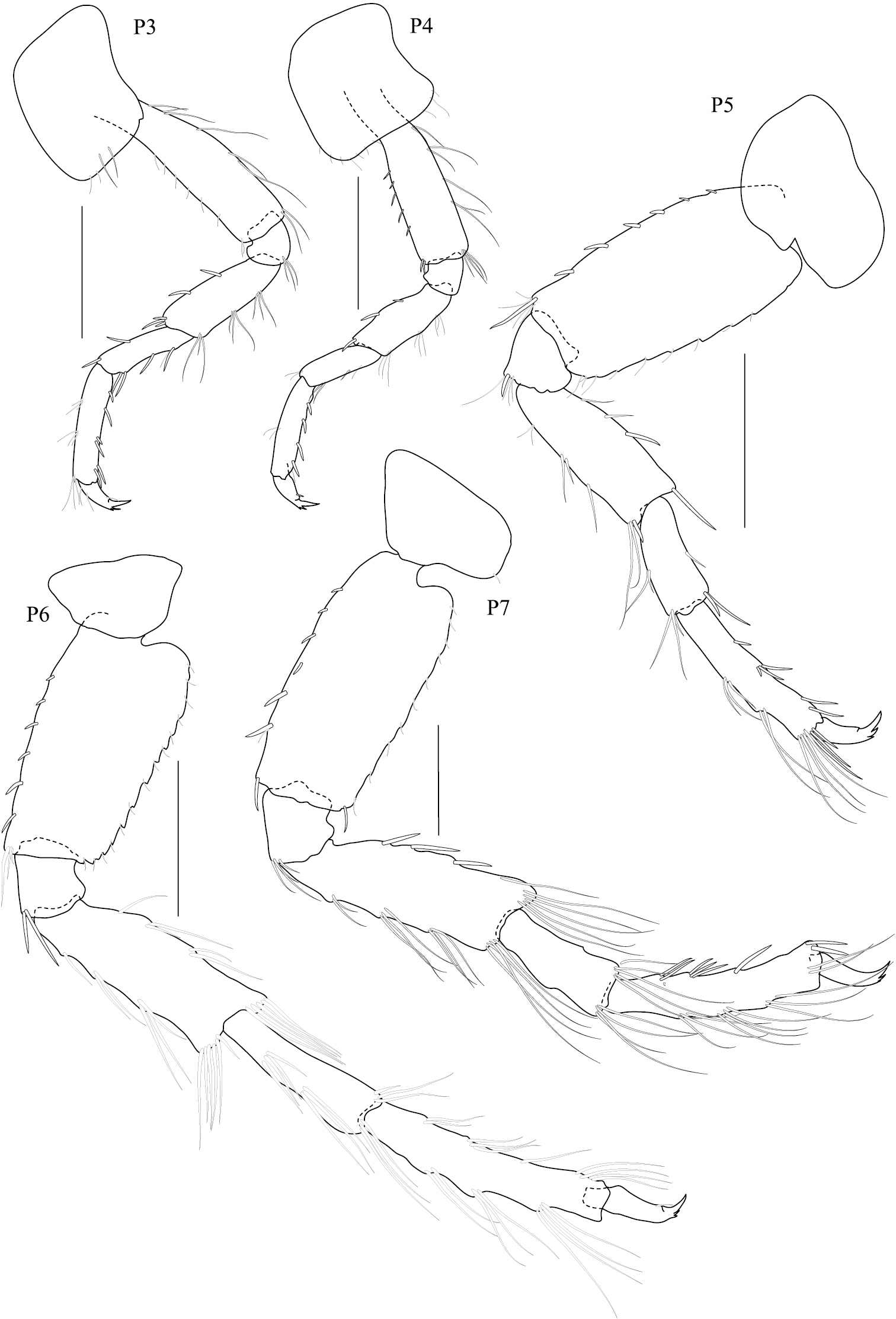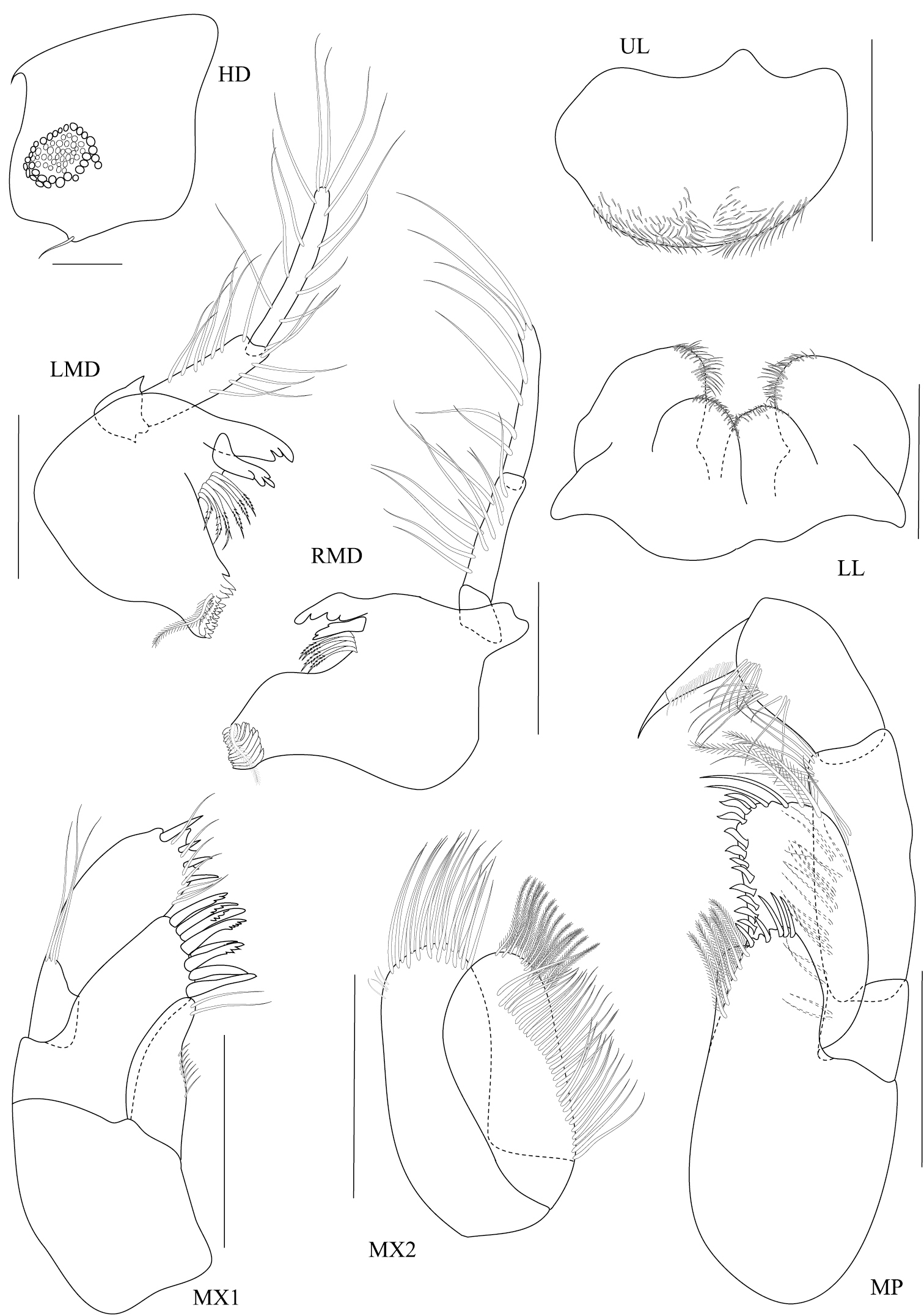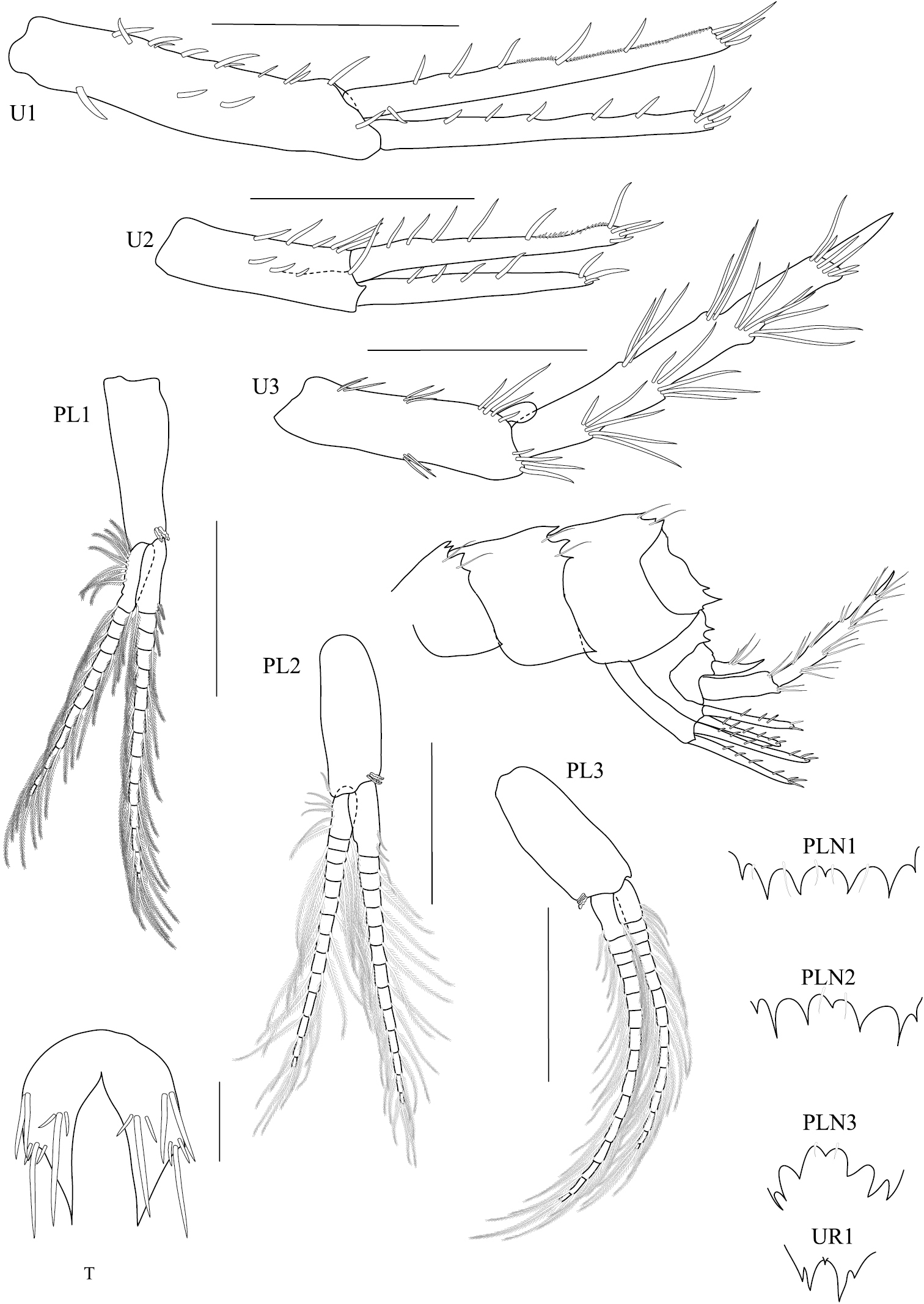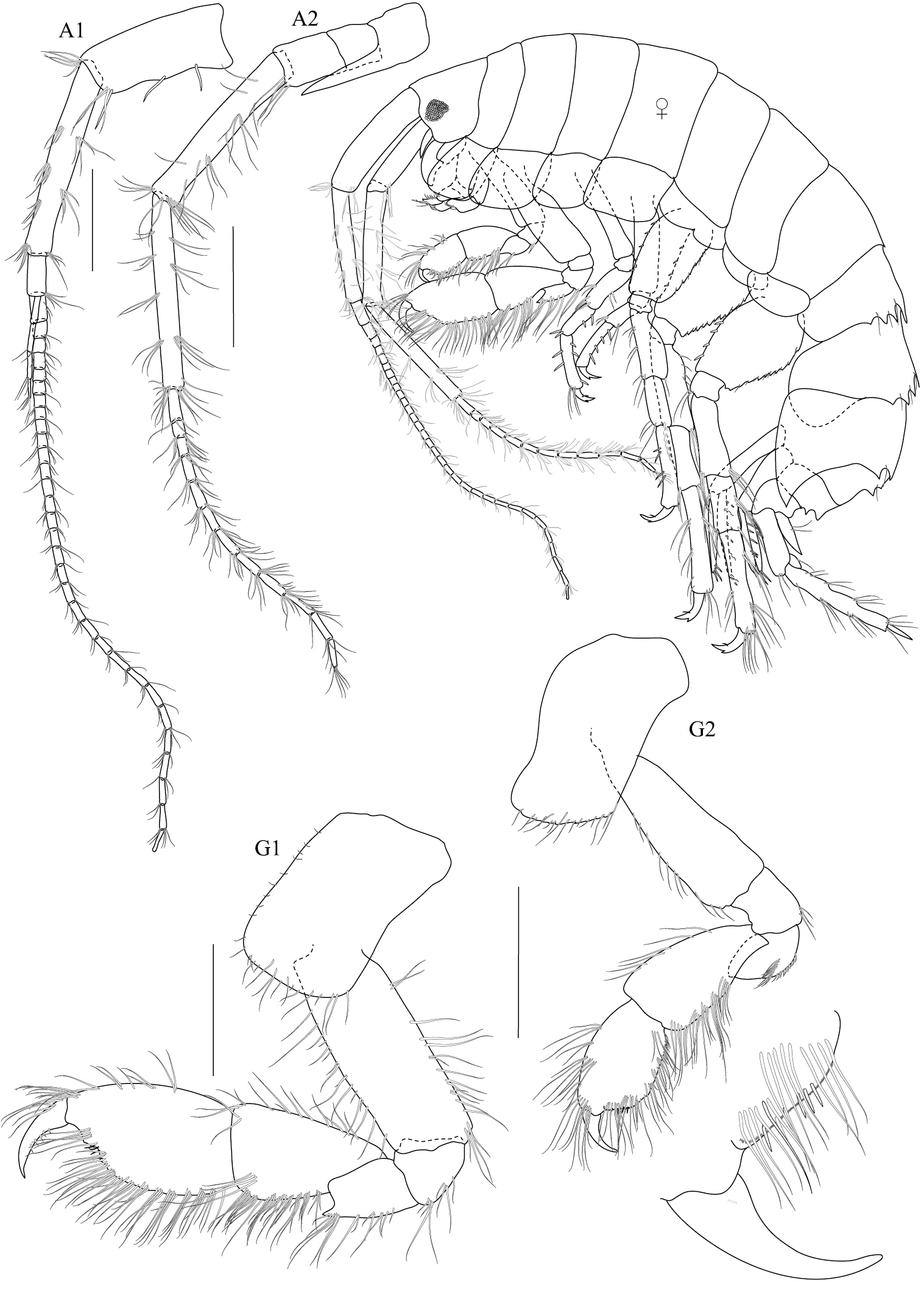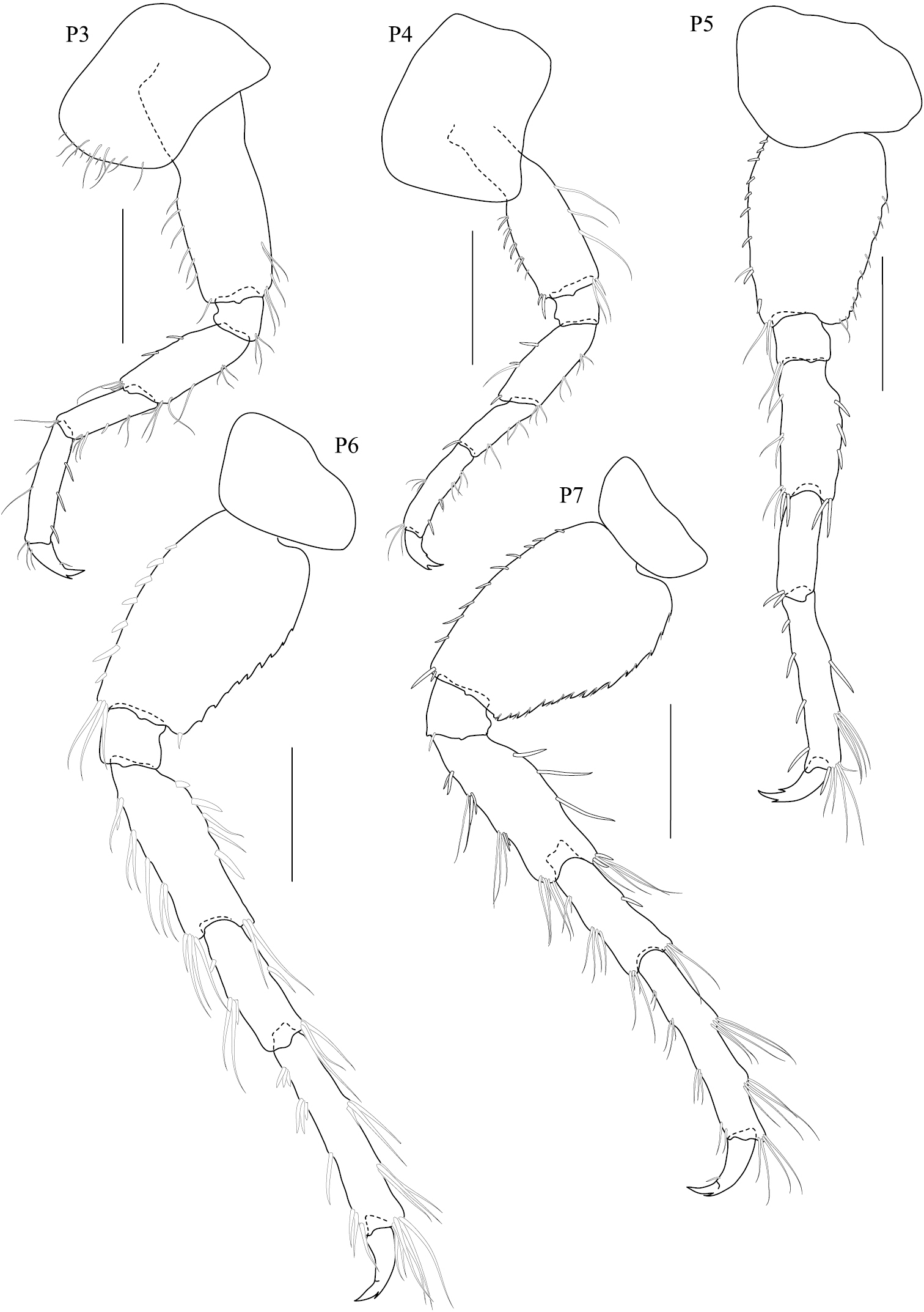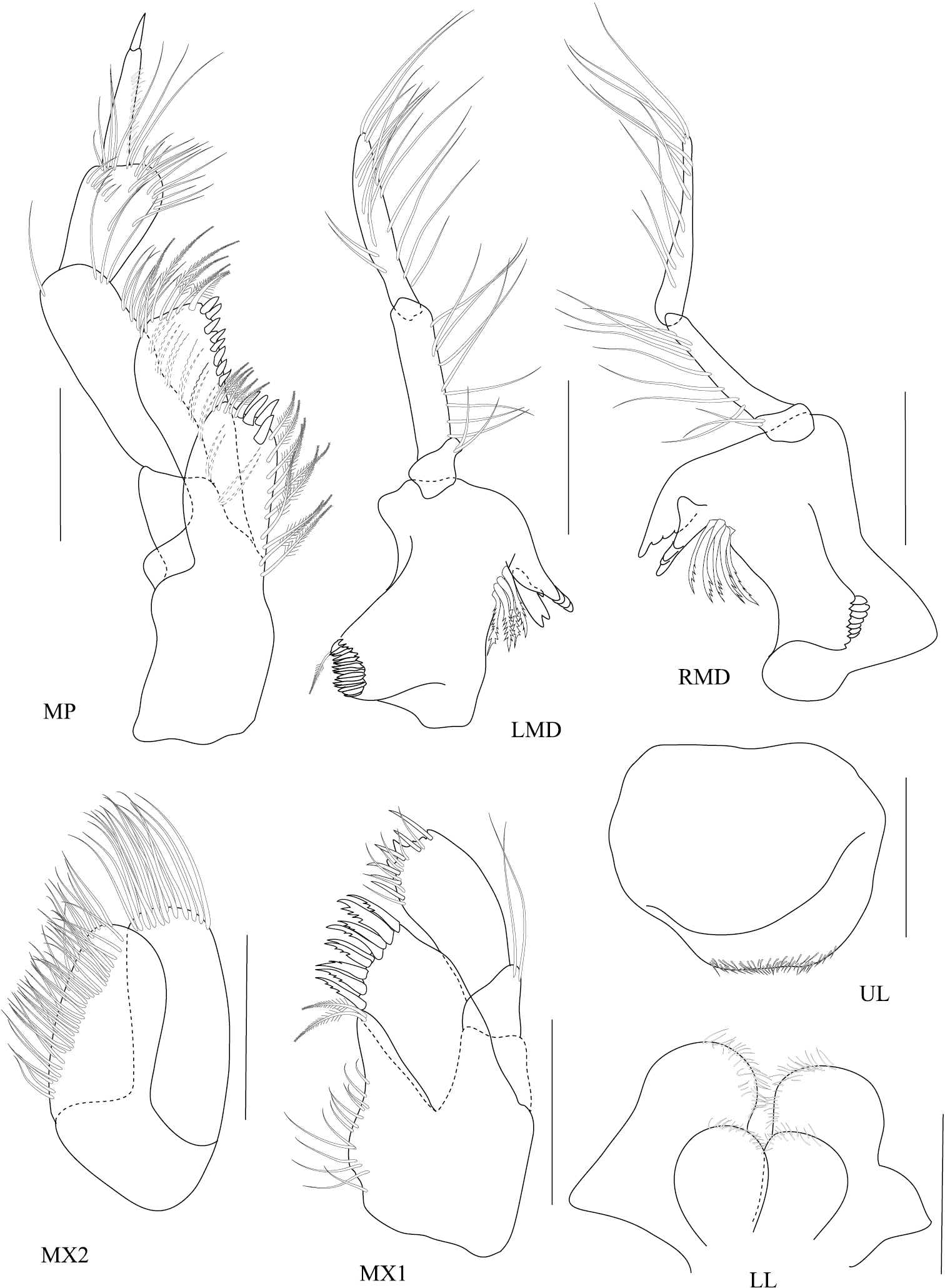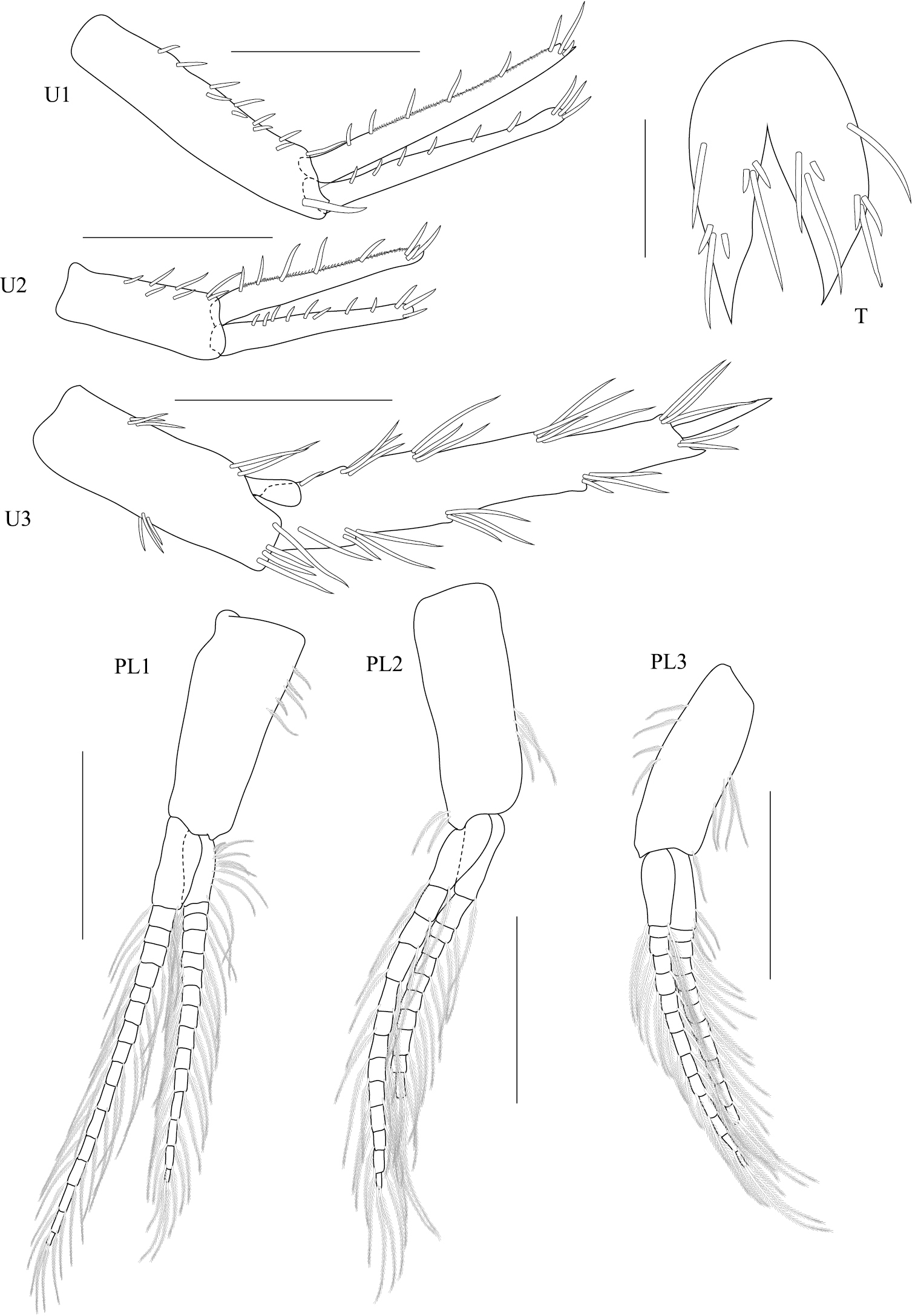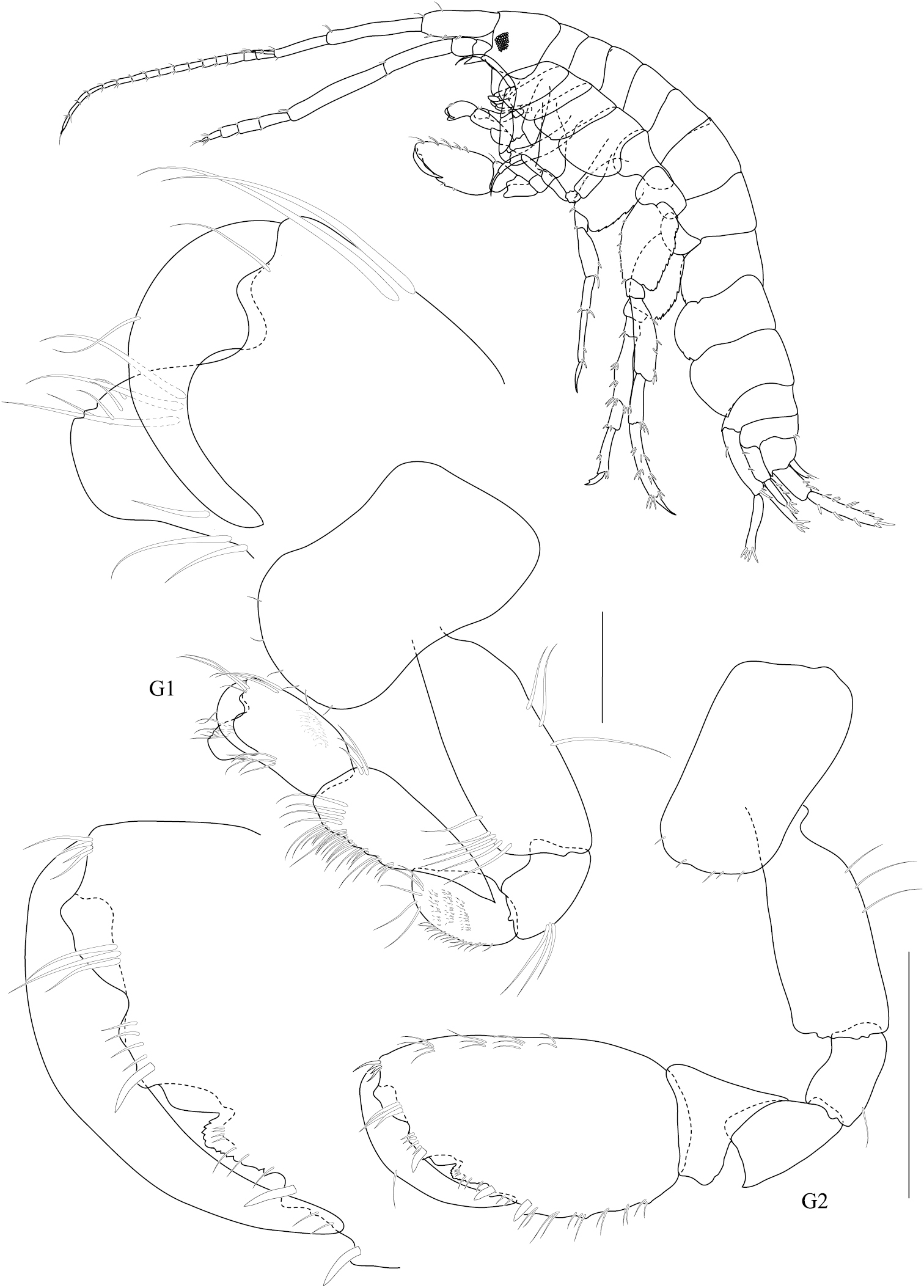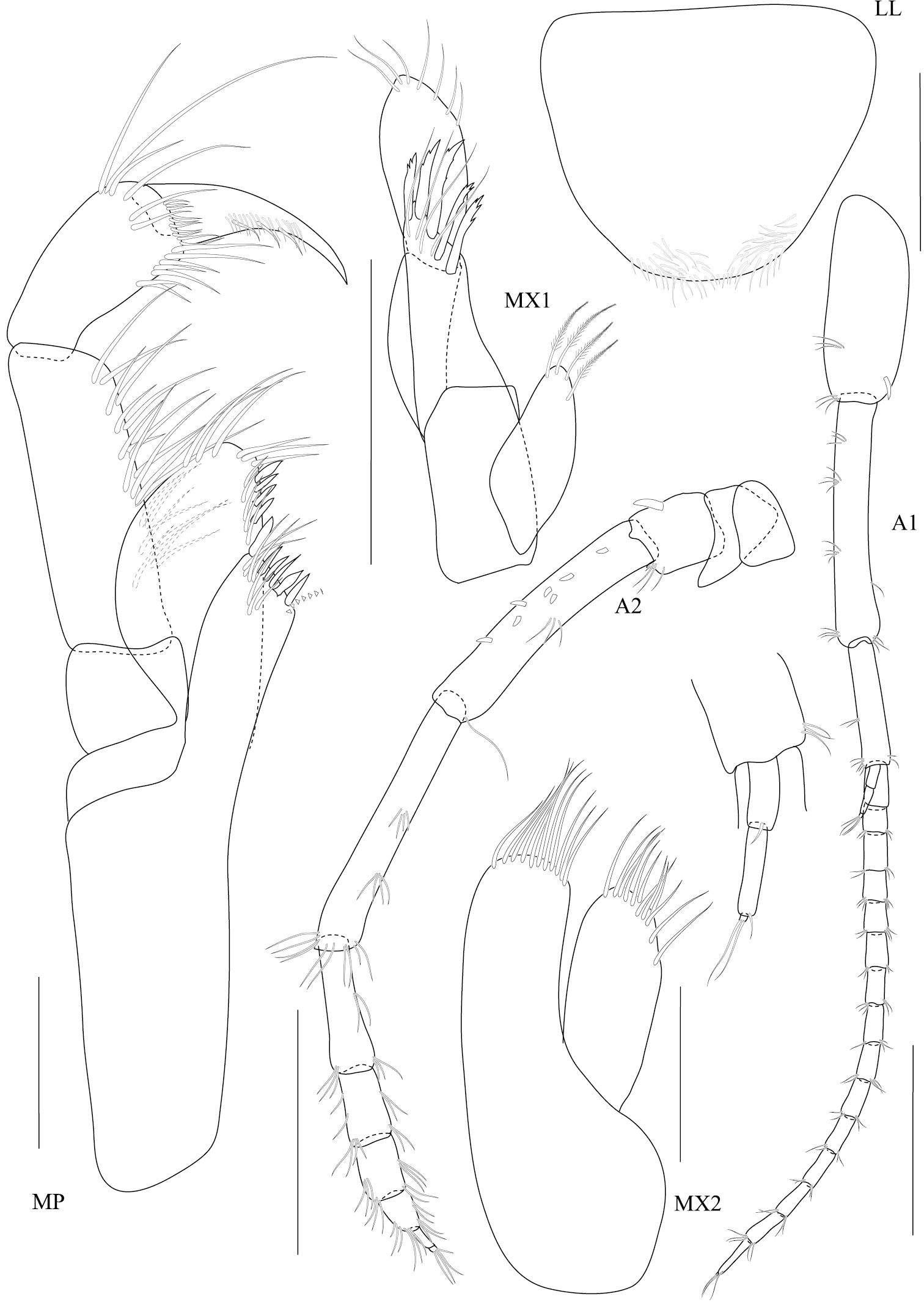






Citation: Wongkamhaeng K, Pattaratumrong MS, Puttapreecha R (2014) Melitid amphipods from the Gulf of Thailand, with a description of Dulichiella pattaniensis, a new species. ZooKeys 408: 1–18. doi: 10.3897/zookeys.408.7292
Two species of melitid amphipod were collected from the Gulf of Thailand. Dulichiella pattaniensis is new to science, and Melitalati latiflagella Ren & Andres, 2012 has not been previously reported from Thai Waters. Dulichiella pattaniensis is characterized by male gnathopod 2 distolateral crown with 4 spines; pleonite/urosomite formula 7-7-7-5-6-2; pereopod 5-7 dactylus with 2 accessory spines. This combination of characters has not been recorded previously in the Dulichiella. The characters of the specimens are described and illustrated. All specimens are deposited in the Princess Maha Chakri Sirindhorn Natural History Museum, Prince of Songkla University, Thailand.
Crustacea, Amphipoda, Melitidae, Dulichiella pattaniensis, Gulf of Thailand, taxonomy
Melitid amphipods most commonly occur in coastal and freshwater areas. Thailand has a variety of aqueous habitats including coral reefs, seagrass beds, and mangrove forests, but only one melitid amphipod, Rotomelita longipropoda Wongkamhaeng et al., 2013 was described. In this study, we describe a new melitid species Dulichiella pattaniensis sp. n., and our observations of Melita latiflagella Ren & Andress, 2012, which has not been previously reported in Thai Waters. Figures and descriptions of both species are provided.
Amphipods were collected from some settlement plates in an artificial reef in Ban Pak Bang Ta Wa, Pattani Bay and from sediment of Lower Songkhla Lake (Figure 1). The sites were visited at low tide and amphipods were collected using a 20×20 cm Ekman grab from the subtidal zone. The amphipod specimens were sorted out and fixed in formalin for 1 week and then stored in 70% alcohol. In the laboratory, the specimens were transferred from alcohol into glycerol for study. Drawing was accomplished using a drawing tube attached to an Olympus CH30 light microscope. The pencil drawings were scanned and digitally inked using a WACOM bamboo CTH-970 graphics board following the method described in
Map of the sampling area.
(
Dulichiella spinosa Stout, 1912 (type by monotypy).
Dulichiella appendiculata Say, 1818; Dulichiella australis Haswell, 1879; Dulichiella celestun Paz-Rios & Ardisson, 2014; Dulichiella cotesi Giles, 1890; Dulichiella cuvettensis Appadoo & Myers, 2005; Dulichiella fresnellii (Audouin, 1826); Dulichiella guinea Lowry & Springthorpe, 2007; Dulichiella lecroyae Lowry & Springthorpe, 2007; Dulichiella oahu Lowry & Springthorpe, 2007; Dulichiella pacifica Lowry & Springthorpe, 2005; Dulichiella pattaniensis sp. n.; Dulichiella spinosa Stout, 1912 (type species); Dulichiella takedai Tomikawa & Komatsu; Dulichiella terminos Lowry & Springthorpe, 2007; Dulichiella tomioka Lowry & Springthorpe, 2007; Dulichiella tulear Lowry & Springthorpe, 2007.
Dulichiella pattaniensis sp. n. holotype, male, (PSUZC-CR-00192), 6.3 mm. Pattani Bay, Lower Gulf of Thailand. All scale bars represent 0.5 mm.
Dulichiella pattaniensis sp. n. paratype, male, (PSUZC-CR-00194), Pattani Bay, Lower Gulf of Thailand. All scale bars represent 0.5 mm.
Dulichiella pattaniensis sp. n. paratype, male, (PSUZC-CR-00194), Pattani Bay, Lower Gulf of Thailand. The scale bars for U1-U3, PL1-3 represent 0.5 mm, but 0.2 mm for T.
Dulichiella pattaniensis sp. n. paratype, male, (PSUZC-CR-00194), Pattani Bay, Lower Gulf of Thailand. All scale bars represent 0.5 mm.
Dulichiella pattaniensis sp. n. allotype, female, (PSUZC-CR-00193), Pattani Bay, Lower Gulf of Thailand. All scale bars represent 0.5 mm.
Dulichiella pattaniensis sp. n. allotype, female, (PSUZC-CR-00193), Pattani Bay, Lower Gulf of Thailand. All scale bars represent 0.5 mm.
Dulichiella pattaniensis sp. n. allotype, female, (PSUZC-CR-00193), Pattani Bay, Lower Gulf of Thailand. All scale bars represent 0.2 mm.
Dulichiella pattaniensis sp. n. allotype, female, (PSUZC-CR-00193), Pattani Bay, Lower Gulf of Thailand. Scale bars for U1-U3, PL1-3 represent 0.5 mm, but 0.2 mm for T.
Holotype. ♂, THAILAND, Lower Gulf of Thailand, Pattani Bay (6°51'55"N, 101°10'7"E), artificial reef (associated with coral settlement plate), 1 September 2010, Puttapreecha, R., PSUZC-CR-0192. Allotypes, ♀ collected with holotype; PSUZC-CR-0193; Paratype, collected with holotype (PSUZC-CR-0194 (5♂; 5♀)).
Based on male holotype. Body length 6.3 mm (from tip of rostrum to apex of telson). Body compressed, subcylindrical. Head, lateral cephalic lobe truncate, anteroventral corner with setae, eyes round. Antenna 1, setiferous, ratios of peduncular articles 1–3 4:5:1; peduncular article 1 with 3 ventromarginal robust setea and distoventral setae; accessory flagellum with 5 articles, last article reduced; primary flagellum 16-articulate (possibly regenerating in this specimen), flagellum can be 25-articulate (observed from additional material). Antenna 2, Antenna 2 setiferous, peduncular article 2 cone gland not reaching end of article 3; article 5 subequal to 4, flagellum 9-articulate.
Upper lip, (labrum) distally rounded. Lower lip, inner lobes well developed, pubescent. Mandible, both similar, left incisor 3 dentates, right incisor 4 dentate; left and right lacinia mobilis armed with 3 and 4 dentates respectively; palp slender with marginal setae, article 1 smooth, article 3 slightly longer than article 2. Maxilla 1, inner plate narrow with 2 apical plumose setae; outer plate with 8 apical serrate robust setae; palp 2-articulate, article 1 with 3 distal setae, article 2 with 4 apical robust setae and 4 apical setae. Maxilla 2, inner plate with mediofacial row of 29 setae and 14 apical plumose setae; outer plate broader than inner plate, distally setose. Maxilliped, inner plate borad, with 6 plumose marginal setae; outer plate margin with 11 conate robust setae, terminal with 4 plumose setae; palp 4-articulate, article 2-3 with marginal setae, article 4 tapering with fine marginal setae.
Pereon. Gnathopod 1 subchelate, smaller than gnathopod 2; coxa anterodistal corner not produced, posteroventral corner notch present, anterior margin straight; length ratio of articles from basis to dactylus 10: 3:4:7:5: 3; basis slender; merus–propodus setose; palm slightly convex, defined by posterodistal corner, without posterodistal robust setae. Gnathopod 2 sexually dimorphic; left and right gnathopods unequal in size; coxa posteroventral corner notch present; (larger) length ratio of article from basis to dactylus 8:1:3:1:10:11; propodus distolateral corner crown with 4 rounded spines, palm straight, posterodistal corner produced, upturned, fit with dactylus; dactylus apically blunt; (smaller) subchelate; length ratio of article from basis to dactylus 9:3:4:6:6:4; merus with sharp posteroventral spine; carpus subequal to propodus; palm straight, without posteroventral spine. Pereopod 3–4 alike. Pereopod 5 basis posterior margin straight, posteroventral corner rounded; carpus and propodus sparsely setose; dactylus unguis anterior margin with accessory spines. Pereopod 6–7 alike, basis, merus, carpus, propodus with long marginal setae. Pereopod 6 basis posterior margin straight, minutely castelloserrate; dactylus unguis anterior margin with accessory spines. Pereopod 7 basis posterior margin straight, with posterior margin minutely castelloserrate, posteroventral corner; dactylus unguis anterior margin with accessory spines.
Pleon. Pleonite/urosomite dorsal spine formula (7-7-7-5-6-2). Pleonites 1–3 with dorsal setae. Epimera 1–3 posteroventral margin without spines above posteroventral corner. Epimeron 3 posterior margin smooth, posteroventral corner with strongly produced acute. Urosomite 1 with spine at midline, no medial gape. Urosomite 2 with dorsal setae. Urosomite 3 with dorsal setae, with 2 dorsal spines. Uropod 3 inner ramus scale-like, much shorter than outer ramus; outer ramus much longer (more than 2× length) than peduncle, 2-articulate. Telson with dorsal robust setae.
Female. (sexually dimorphic characters). Length, 7.4 mm. Gnathopod 1 coxa 4 anterodistal corner not produced, posteroventral corner notch present, anterior margin excavated. Gnathopod 2 equal, coxa subrectangular, palm crenulated, oblique with setae on margins. Pereopod 7 basis expanded, posterior margin slightly convex.
This species is named after the type locality.
Dulichiella pattaniensis sp. n., with pleonite/urosome formular of 7-7-7-5-6-2 has only Dulichiella cotesi, Dulichiella oahu, Dulichiella pacifica and Dulichiella tulear that share this characters. This new species can be distinguished from Dulichiella cotesi, Dulichiella oahu and Dulichiella tulear by having male gnathopod 2 (large) with 4 spines on distolateral crown while those three species have 3 spines. Dulichiella pattaniensis differs from Dulichiella pacifica in the following: the male large gnathopod 2 has a fourth spine on its distolateral crown that is not well developed vs. its well-developed fourth set of spines. The male gnathopod 1 has carpus longer than its propodus vs. a carpus subequal to its propodus. Pereopods 3-4 have a dactyli with 2 accessory spines vs. 3-4 dactyli with 1 accessory spine.
The new species also has four spines on the distolateral crown of the male gnathopod 2. Only 7 species, Dulichiella appendiculata, Dulichiella cuvettensis, Dulichiella celestun, Dulichiella fresnellii, Dulichiella guinea, Dulichiella lecroyae, Dulichiella pacifica and Dulichiella takedai share this distinct character. Dulichiella pattaniensis can be distinguished from amphipods by having pleonite/urosome formular of 7-7-7-5-6-2 while Dulichiella appendiculata, Dulichiella cuvettensis, Dulichiella fresnellii, Dulichiella lecroye and Dulichiella pacifica pleonite/urosome formula 7-7-7-5-4-2, Dulichiella guinea 9-9-7-5-4-2 and Dulichiella celestun 9-9-9-5-6-2. Moreover, Dulichiella pattaniensis differs from Dulichiella cuvettensis, Dulichiella guinea and Dulichiella lecroyae by having 2 accessory spines on pereopods 3-4 dactyli vs. 1 accessory spine. A summary of these distinguishing characters are given in Table 1.
A summary of the diagnostic characteristicsthat serve to distinguishclosely related Dulichiella species.
| accessory flagellum | lateral cephalic lobe | male large G2 distolateral crown | male G1 coxa anterior margin | male G1 carpus: propodus | male G2 dactylus | pereopod 3–4 dactyli | pereopod 6-7 | pleonite/urosome formular | epimera 3 posteroventral margin | |
|---|---|---|---|---|---|---|---|---|---|---|
| Dulichiella pattaniensis | 5 articles | truncate | with 4 spines, fourth spine not well developed | straight | > | overlapping into palm posterodistal corner | with 2 accessory spines | with bunch of long setae on merus carpus and propodus | 7-7-7-5-6-2 | smooth |
| Dulichiella appendiculata | 5 articles | truncate | with 4 spines, fourth spine not well developed | concave | = | fitting into palm posterodistal corner | with 2 accessory spines | with bunch of long setae on basis merus carpus and propodus | 7-7-7-5-4-2 | smooth |
| Dulichiella cotesi | 3 articles | truncate | with 3 spines | straight | = | fitting into palm posterodistal corner | with 1 accessory spine | with bunch of long setae on merus carpus and propodus | 7-7-7-5-6-2 | smooth |
| Dulichiella cuvettensis | 4 articles | truncate | with 4 spines, fourth spine not well developed | straight | > | overlapping into palm posterodistal corner | with 1 accessory spine | with bunch of long setae on carpus and prooodus | 7-7-7-5-4-2 | serrate |
| Dulichiella fresnellii | 4 articles | truncate | with 4 spines, fourth spine not well developed | concave | > | overlapping into palm posterodistal corner | with 2 accessory spines | with bunch of long setae on carpus and prooodus | 7-7-7-5-4-2 | smooth |
| Dulichiella guinea | 5 articles | truncate | with 4 spines, fourth spine well developed | straight | = | fitting into palm posterodistal corner | with 1 accessory spine | with bunch of long setae on basis merus carpus and propodus | 7-7-7-5-4-2 | smooth |
| Dulichiella lecroyae | 4 articles | rounded | with 4 spines, fourth spine well developed | straight | > | fitting into palm posterodistal corner | with 1 accessory spine | with bunch of long setae on carpus and prooodus | 7-7-7-5-4-2 | smooth |
| Dulichiella oahu | 4 articles | truncate | with 3 spines | straight | = | fitting into palm posterodistal corner | with 2 accessory spines | with bunch of long setae on carpus and prooodus | 7-7-7-5-6-2 | smooth |
| Dulichiella pacifica | 4 articles | truncate | with 4 spines, fourth spine well developed | straight | = | fitting into palm posterodistal corner | with 1 accessory spine | with bunch of long setae on carpus and prooodus | 7-7-7-5-4-2/6-2 | smooth |
| Dulichiella takedai | 4 articles | truncate | with 4 spines, fourth spine well developed | straight | > | overlapping into palm posterodistal corner | with 2 accessory spines | with bunch of long setae on merus carpus and propodus | 7-6-7-5-4-2 | serrate |
| Dulichiella tulear | no data | truncate | with 3 spines | convex | < | fitting into palm posterodistal corner | with 1 accessory spine | without bunch of long setae | 7-7-7-5-6-2 | serrate |
http://species-id.net/wiki/Melita_latiflagella
Figures 10, 11Lower Gulf of Thailand, Songkhla Lake (09°18'39.5"N, 99°46'46.4"E), 1 Feb 2012, Wongkamhaeng, K. PSUZC-CR-0191. (10♂; 10♀).
Melita latiflagella male (PSUZC-CR-000191) 4 mm. Outer Sonkhla Lake, lower Gulf of Thailand. All scale bars represent 0.2 mm.
Melita latiflagella male (PSUZC-CR-000191) 4 mm. Outer Sonkhla Lake, lower Gulf of Thailand. All scale bars represent 0.2 mm.
Hainan province, China Sea.
Head. Lateral cephalic lobe smooth. Antenna 1 peduncular article 1 longer than article 2, posterior margin with 2 marginal robust setae and 1 ventrodistal robust seta; flagellum with 19 articles, accessory flagellum 2 articles. Antenna 2 gland cone not reaching to the end of article 3; flagellum with 5 articles. Lower lip inner lobes well developed, outer lobes pubescent. Maxilla 1 inner plate with 3 terminal plumose setae. Mandibular palp article 2 subequal to article 1.
Pereon. Gnathopod 1 coxa anteroventral corner slightly produced, posteroventral corner expanded; merus-propodussetose; carpus longer than propodus; propodus transverse, venterodistal corner produced, without defining robust seta on anteroventral corner; dactylus overlapping palm. Gnathopods 2 merus posterodistal corner produced; carpus naked; propodus 3 × of carpus length, palmar margin oblique, serrated, longer than hind margin, with 2 robust setae, posterodistal corner produced with a robust seta; dactylus fit with palmar margin. Pereopod 3 coxa subrectangular. Pereopod 4 similar to pereopod 3; coxa distally expanded. Pereopod 5 and 6 basis posterior margin rounded. Pereopod 7 basis posterior margin straight.
Pleon. Epimera 1–3 rounded. Pleonite 1–3 dorsally smooth. Uropod 1 peduncle with venterodistal spine, bearing marginal robust setae, both rami with a row of marginal robust setae. Uropod 2 peduncle shorter than rami; rami subequal. Telson cleft each half with 2 apical robust setae.
China Sea and Songkhla Lake (current study).
I would like to thank Dr. Jaruwat Nabhitabhata and Mr. Kwan Nualcharoen for assisting me in this research with their insights and expertise. Mr. Sarawoot Gomuttapong was a source of inspiration for this work and Dr. Azman Abdul Rahim drew maps of the sampling area. We gratefully acknowledge Dr. Charles Oliver Coleman from the Museum of für Naturkunde in Berlin, Germany, and Dr. Jim Lowry from the Australian Museum in Sydney, for their assistance with the literature.
